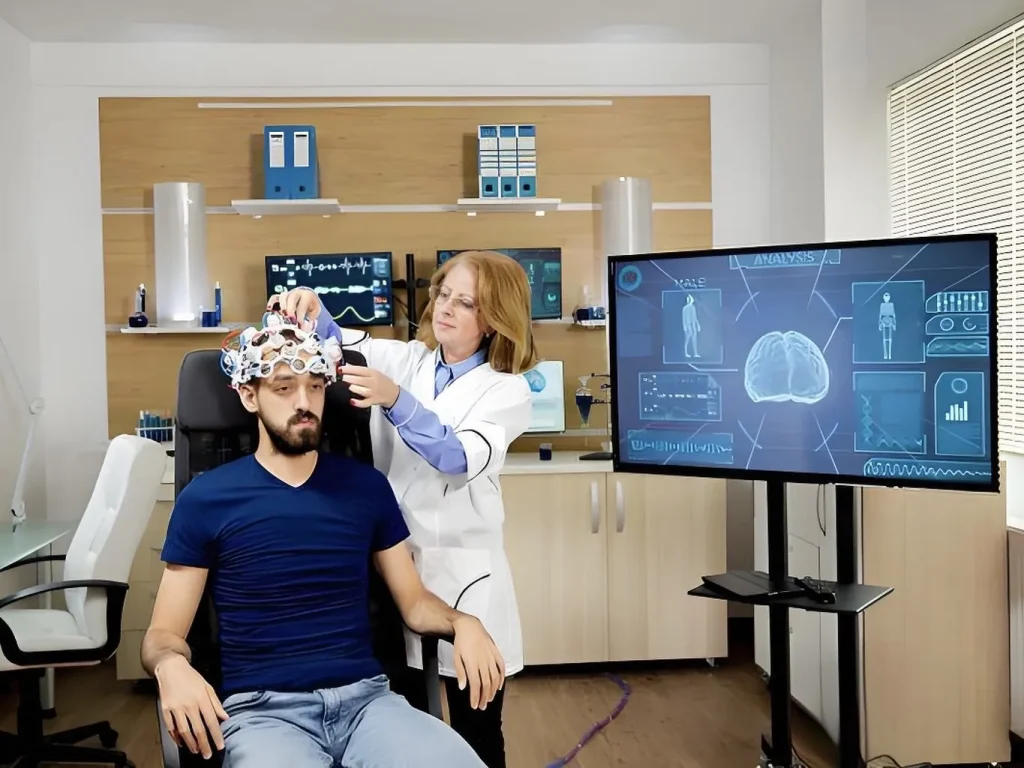- Australian scientists have invented the world’s first “mind-reading” head-mounted device that can translate human brain waves into text.
- This technology could help patients who are unable to speak due to illness, aid law enforcement interrogations and improve military capabilities, but it could also increase the leakage of personal privacy and even state secrets, causing social chaos.
OUR TAKE
In the X-Men series, Professor Charles’ ability to read minds is often the key to the main characters’ fight and survival. He reads other people’s minds to gain important intelligence on the battlefield, including enemy plans and intentions, which allows the X-Men to respond to enemy movements more accurately and effectively in combat.This ability is very similar to the mind-reading helmet featured in this article.
–Zora Lin, BTW reporter
In science fiction literature and movies, a mind-reading helmet is often portrayed as a mysterious and powerful device that reads the thoughts and emotions of others. If such a device does enter our real world, what kind of wonder and chaos will it cause?
Although mind-reading helmet has infinite potential to improve communication, enhance interpersonal relationship and promote scientific progress, there are also severe privacy issues and psychological safety challenges, which we need to timely respond to to avoid the technological catastrophe.
Birth of the mind-reading helmet
Just like professor Charles’s superpowers in X-Men, earlier this year Australian scientists developed the world’s first “mind reading” head-mounted smart device, which can “translate” human brain waves into words, but it is still in the testing stage. It is based on the principle of EEG scanning.
“The technology is non-invasive despite the fact it’s said to be translating your brainwaves, relatively inexpensive and easily transportable.”
Chin-Teng Lin, researcher of University of Technology Sydney
The revolutionary research comes from a team at the University of Technology Sydney. The mind-reading helmet works by the user wearing a special helmet full of sensors that monitor specific electrical activity in the brain as the user thinks, and then switching to an artificial intelligence model to decode and translate it into text.
One example asks the participant to think: “Good afternoon! I hope you’re doing well. I’ll start with a cappuccino, please, with an extra shot of espresso.”
The screen reads: “Afternoon! You well? Cappuccino, Xtra shot. Espresso.”
Which you have to admit, is a pretty close match!
“This research represents a pioneering effort in translating raw EEG waves directly into language, marking a significant breakthrough in the field.The integration with large language models is also opening new frontiers in neuroscience and AI.”
Chin-Teng Lin, researcher of University of Technology Sydney
At present, the mind-reading helmet can correctly “interpret” 45% of commands, but the researchers expect this to be improved to more than 90% in the future.
Also read: Could ChatGPT’s Dan be the perfect boyfriend?
Also read: What screams ‘phishing scam’? Recognising unmistakable signs
Explore wonderful world of mind-reading helmet
Communication breakthrough
Mind-reading helmets can help people directly read the minds of others, eliminating language barriers and misunderstandings. Without words, we can directly understand each other’s intentions and feelings, making communication more direct and efficient. For example, a person using a mind-reading helmet can directly understand the other person’s thoughts and emotions when communicating with a foreign friend who does not speak the language, promoting cross-cultural communication and understanding.
Spiritual connection
This technology can deepen the emotional connection between people. By reading directly into the hearts of others, we can more deeply understand and share each other’s joy, pain and thoughts. For example, family members can be more sensitive to each other’s emotional states and better able to support and care for each other.

Advances in science and medicine
The mind-reading helmet could revolutionise the fields of psychology and neuroscience. Scientists can delve into and understand how the human brain works and mental processes, providing new insights into treating mental illness and understanding cognitive function. For example, in the treatment of autism or aphasia, the mind-reading helmet can help doctors more accurately understand the patient’s inner world and develop a more personalised and effective treatment plan.
Pop quiz:
What is the principle behind the mind-reading helmets?
A. Electroencephalogram (EEG)
B. Artificial Intelligence
C. Virtual reality
D. Thermal Imaging
The correct answer is at the bottom of the article.
Chaos brought by mind-reading helmet
Threat to privacy
The most obvious problem is the invasion of privacy. If the mind-reading helmet is misused, an individual’s private thoughts and feelings could be leaked or misused, raising serious ethical and legal issues. For example, employers or government departments may attempt to use mind-helmets to monitor the minds of employees or citizens, and such abuse can lead to serious violations of individual rights and freedoms.
Miscommunication and confusion
Although the mind-reading helmet can understand the thoughts of others, the human mind is complex and changeable, and sometimes our thinking is not always clear and consistent. This can lead to misunderstanding and confusion, especially when complex emotions or multi-layered thought processes are involved. For example, in a romantic relationship, even being able to read your partner’s mind can lead to difficulties in communication and understanding due to emotional changes and inconsistencies.

Challenge of psychological security and self-preservation
Having a mind-reading helmet may make people feel psychologically vulnerable and insecure. Knowing that someone else can read their mind at any time can lead people to try to hide or control their thoughts and not be afraid to truly express their true thoughts and feelings. For example, in social situations, people may choose to remain silent for fear that others will know their true thoughts, leading to the deterioration of communication and social skills.
“The research will use robots to implant a brain-computer interface in the area of the brain that controls intent to move, adding that its initial goal is to enable people to control a computer cursor or keyboard with just their thoughts.”
Neuralink, Elon Musk’s brain-chip startup
Other concerns
While the technology could help patients who are unable to speak due to disease, translating brain signals into speech requires implanted electrodes or scans in the brain, which is dangerous, expensive and difficult to use on a daily basis.
It may lead to social disorder. There are currently no clear laws governing this highly invasive technology, and the boundaries of its use are blurred.
Interesting scenarios for future
If the famous Chinese writer Yu Hua or Mo Yan wear the “mind-reading helmet”, the literary spark in their brain will be fully presented, Yu Hua’s “Alive”, “Xu Sanguan Selling Blood”, Mo Yan’s “Red Sorghum” and “Life and Death Fatigue” will be a different look, and all kinds of magical ideas captured in the original are presented, what is the scene. Little by little, the boundaries of the human mind are being broken.
The Defense Intelligence Agency has issued a statement calling on the military to increase investment in neuroscience technology, including research into techniques to “put the enemy at their command.” There is speculation that the “telepathic helmet” could one day replace waterboarding and other torture methods to read the minds of suspected terrorists.
“In modern times, we all learn to fight through video games and plastic weapons. Today it’s a science fiction weapon, tomorrow it could be in the field, and if the helmet can save me from having to listen to my superiors, so be it.”
Some soldiers who welcomes the “telepathic helmet” research
Science and technology not only bring benefits to mankind, but also threaten our existence. Some scholars have proposed to establish the ethics of fear, and only in this kind of fear can prospective prevention be carried out. There are also experts calling for AI to be “aligned with human values.”
A line should be drawn here, that is, science and technology should not disturb the inherent human pursuit of peace, harmony, order of the world as the premise. The purpose of developing technology is to live a more comfortable and better life, not to be anxious and upset. Use the “mind-reading helmet” on patients who have suffered a stroke or paralysis and are unable to speak, rather than prying into other people’s privacy.
There is an old Chinese saying, “Born in constraint, die in freedom.” The relationship between science and technology and ethics is often compared to feet and shoes, science and technology are feet, ethics are shoes, wearing ethical “shoes”, science and technology “feet” can walk steadily, prudently deal with the extreme tendency of scientism and technological optimism, warm and friendly to serve the society.
The correct answer is A, Electroencephalogram (EEG).
